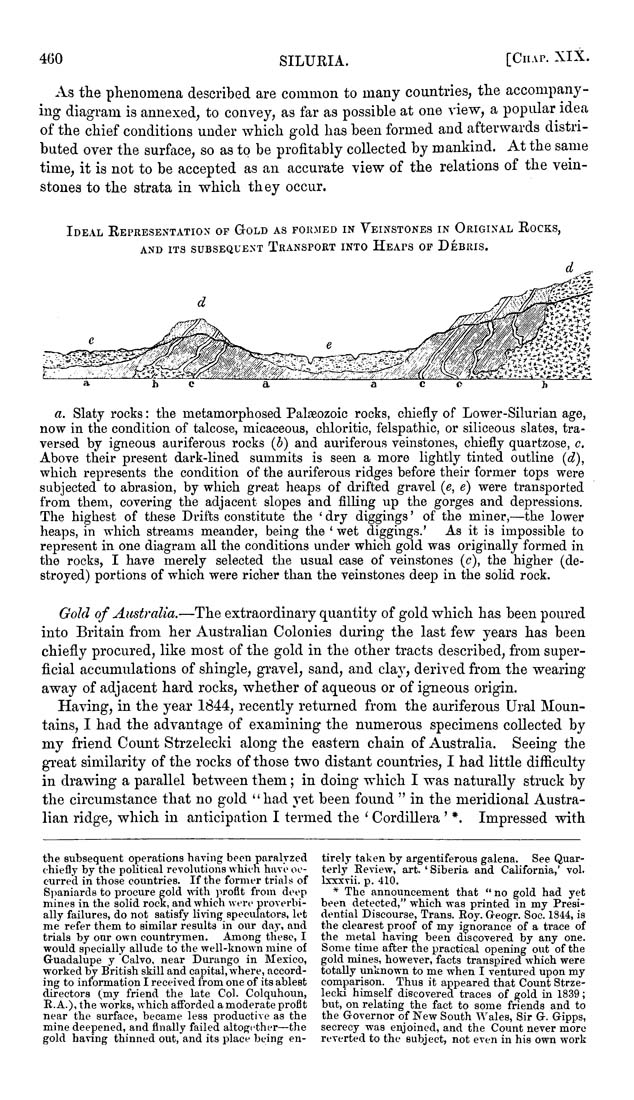460
SILURIA.
[Ciiap. XIX.
As the phenomena described are common to many coimtries, the accompany¬
ing diagram is annexed, to convey, as far as possible at one view, a popular idea
of the chief conditions under which gold has been formed and afterwards distri¬
buted over the surface, so as to be profitably collected by mankind. At the same
time, it is not to be accepted as an accurate view of the relations of the vein¬
stones to the strata in which they occur.
Ideal Representation of Gold as formed in Veinstones in Original Rocks,
AND ITS subsequent TRANSPORT INTO HeAPS OF DeBRIS.
a. Slaty rocks: the metamorphosed Palaeozoic rocks, chiefly of Lower-Silurian age,
now in the condition of talcose, micaceous, chloritic, felspathic, or siliceous slates, tra¬
versed by igneous aariferous rocks {b) and auriferous veinstones, chiefly quartzose, c.
Above their present dark-fined summits is seen a more lightly tinted outline {d),
which represents the condition of the auriferous ridges before their former tops were
subjected to abrasion, by which great heaps of drifted gravel {e, e) were transported
from them, covering the adjacent slopes and filling up the gorges and depressions.
The highest of these Drifts constitute the ' dry diggings' of the miner,—the lower
heaps, in which streams meander, being the ' wet diggings.' As it is impossible to
represent in one diagram aU the conditions under which gold was originally formed in
the rocks, I have merely selected the usual case of veinstones (<?), the higher (de¬
stroyed) portions of which were richer than the veinstones deep in the sohd rock.
Gold of Australia.—The extraordinary quantity of gold which has been poured
into Britain from her Australian Colonies during the last few years has been
chiefly procured, like most of the gold in the other tracts described, from super¬
ficial accumulations of shingle, gravel, sand, and cla}", derived from the wearing
away of adjacent hard rocks, whether of aqueous or of igneous origin.
Having, in the year 1844, recently returned from the auriferous Ural Moun¬
tains, I had the advantage of examining the numerous specimens coUected by
my friend Count Strzelecki along the eastern chain of Australia. Seeing the
great similarity of the rocks of those two distant countries, I had little difficulty
in drawing a parallel between them; in doing which I was natm'ally struck by
the circumstance that no gold "had yet been found " in the meridional Austra¬
lian ridge, which iu anticipation I termed the ' CordiUera ' *. Impressed with
the subsequent operations having been paralyzed
chiefly by the political revolutions which have oc¬
curred in those countries. If the former trials of
Spaniards to procure gold with profit from deep
mines in the solid rock, and which were proverbi¬
ally failures, do not satisfy living speculators, let
me refer them to similar results in our day, and
trials by our own countrymen. Among these, I
would specially allude to the well-known mine of
Guadalupe y Calvo, near Dm-ango in Mexico,
worked by British skill and capital, where, accord¬
ing to information I received from one of its ablest
directors (my friend the late Col. Colquhoun,
E.A.), the works, which afforded a moderate profit
near the surface, became less productive as the
mine deepened, and finally failed altogether—the
gold having thinned out, and its place being en¬
tirely taken by argentiferous galena. See Quar¬
terly Eeview, art. 'Siberia and California,' vol.
Ixsxvii. p. 410.
* The announcement that "no gold had yet
been detected," which was printed in my Presi¬
dential Discourse, Trans. Eoy. G-eogr. Soc. 1844, is
the clearest proof of my ignorance of a trace of
the metal having been discovered by any one.
Some time after the practical opening out ofthe
gold mines, however, facts transpired which were
totally unknown to me when I ventured upon my
comparison. Thus it appeared that Count Strze¬
lecki himself discovered traces of gold in 1839;
but, on relating the fact to some friends and to
the G-overnor of New South Wales, Sir Gr. Gipps,
secrecy was enjoined, and the Count never more
reverted to the subject, not even in his own work
|








